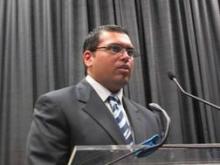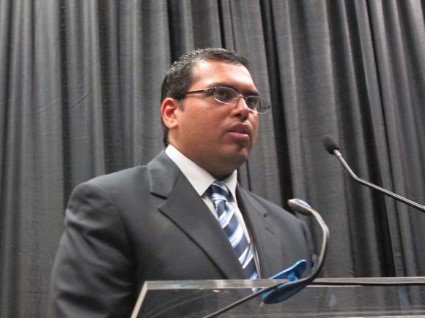User login
SAN JUAN, P.R. – To extubate or to keep the patient on a ventilator? That is the question which, when answered by a respiratory therapy team before the next morning’s rounds began, halved the rate of ventilator-associated pneumonias and significantly decreased the time patients spent on ventilators in a surgical critical care unit, investigators reported at the annual Congress of the Society of Critical Care Medicine.
Previously, spontaneous breathing tests had occurred either during or after morning rounds, with extubations being left until sometime later in the day. Under the new protocol, however, respiratory therapists assigned exclusively to the surgical CCU conducted rounds three times daily, consulted with nurses and physicians, and performed spontaneous breathing tests as recommended under joint 2001 guidelines. Thus armed with the information, the multiprofessional team could make the final decision to extubate, and the extubation itself could occur at morning rounds, getting patients off the ventilator that much sooner, said Dr. Vijay Jayaraman, a resident in surgery at the Christiana Care Health System in Wilmington, Del.
Under the new protocol, Dr. Jayaraman and his colleagues saw the rate of ventilator-associated pneumonia (VAP) events decline from 10.8/1,000 ventilator days before the protocol was implemented, to 5.3/1,000 afterward (P less than .05). The mean time to start a spontaneous breathing trial dropped from 2.67 to 1.77 days (P = .004), and the time to extubation was shortened by a full day, 4.47 to 3.43 days (P = .033). There was no difference in days spent in the CCU post extubation, days spent on the patient floor after the CCU stay, or hospital length of stay, Dr. Jayaraman reported.
"This was established in a CCU that was already fully functioning with an active care team. It just required some reorganization, and the most important thing is that the respiratory therapist can be empowered to help us and actively drive the spontaneous breathing test and extubation process," he commented.
Dr. Juliana Barr, who moderated the session at which Dr, Jayaraman presented his study, commented that although myriad other groups have published ventilator-weaning protocols incorporating respiratory therapists, she was not aware of any studies that had previously shown a reduction in VAP rates.
"That was a low-hanging fruit study waiting for someone to do it, and I’m glad that you came along and did that. Thank you," she told Dr. Jayaraman. Dr. Barr is the acting medical director of critical care at the VA Palo Alto (Calif.) Health Care System.
The respiratory team uses predetermined criteria in a coordinated process consisting of awakening patients, performing the spontaneous breathing test, and, whenever possible, making the decision to extubate either before or during rounds.
For the study, the authors prospectively collected data on 180 patients admitted to their 28-bed level 1 surgical CCU from July through December 2010, before the protocol was implemented, and in 219 patients admitted over the same months in 2011, after the protocol had been in place for 6 months.
Extubate when the time is right
In a separate study, investigators from Montefiore Medical Center and other New York City institutions looked at whether outcomes following extubations in the CCU differed according to the time of day.
They retrospectively studied records of 2,240 patients on mechanical ventilation in 1 of 5 CCUs, and found that there were no significant differences in either 24-hour or 72-hour reintubation rates or in morality between patients extubated during daytime hours or during the night.
"Our data provides evidence that nighttime extubation is itself not associated with elevated risk of reintubation or mortality. Patients should be extubated when weaning parameters are met, irrespective of time of day, with appropriate staffing and resources," Dr. Bryan R. Tischenkel said in a poster presentation. Dr. Tischenkel is an anesthesia resident at New York Presbyterian Hospital.
Both studies were internally funded. Dr. Jayaraman, Dr. Barr, and and Dr. Tischenkel each reported having no relevant financial disclosures.
SAN JUAN, P.R. – To extubate or to keep the patient on a ventilator? That is the question which, when answered by a respiratory therapy team before the next morning’s rounds began, halved the rate of ventilator-associated pneumonias and significantly decreased the time patients spent on ventilators in a surgical critical care unit, investigators reported at the annual Congress of the Society of Critical Care Medicine.
Previously, spontaneous breathing tests had occurred either during or after morning rounds, with extubations being left until sometime later in the day. Under the new protocol, however, respiratory therapists assigned exclusively to the surgical CCU conducted rounds three times daily, consulted with nurses and physicians, and performed spontaneous breathing tests as recommended under joint 2001 guidelines. Thus armed with the information, the multiprofessional team could make the final decision to extubate, and the extubation itself could occur at morning rounds, getting patients off the ventilator that much sooner, said Dr. Vijay Jayaraman, a resident in surgery at the Christiana Care Health System in Wilmington, Del.
Under the new protocol, Dr. Jayaraman and his colleagues saw the rate of ventilator-associated pneumonia (VAP) events decline from 10.8/1,000 ventilator days before the protocol was implemented, to 5.3/1,000 afterward (P less than .05). The mean time to start a spontaneous breathing trial dropped from 2.67 to 1.77 days (P = .004), and the time to extubation was shortened by a full day, 4.47 to 3.43 days (P = .033). There was no difference in days spent in the CCU post extubation, days spent on the patient floor after the CCU stay, or hospital length of stay, Dr. Jayaraman reported.
"This was established in a CCU that was already fully functioning with an active care team. It just required some reorganization, and the most important thing is that the respiratory therapist can be empowered to help us and actively drive the spontaneous breathing test and extubation process," he commented.
Dr. Juliana Barr, who moderated the session at which Dr, Jayaraman presented his study, commented that although myriad other groups have published ventilator-weaning protocols incorporating respiratory therapists, she was not aware of any studies that had previously shown a reduction in VAP rates.
"That was a low-hanging fruit study waiting for someone to do it, and I’m glad that you came along and did that. Thank you," she told Dr. Jayaraman. Dr. Barr is the acting medical director of critical care at the VA Palo Alto (Calif.) Health Care System.
The respiratory team uses predetermined criteria in a coordinated process consisting of awakening patients, performing the spontaneous breathing test, and, whenever possible, making the decision to extubate either before or during rounds.
For the study, the authors prospectively collected data on 180 patients admitted to their 28-bed level 1 surgical CCU from July through December 2010, before the protocol was implemented, and in 219 patients admitted over the same months in 2011, after the protocol had been in place for 6 months.
Extubate when the time is right
In a separate study, investigators from Montefiore Medical Center and other New York City institutions looked at whether outcomes following extubations in the CCU differed according to the time of day.
They retrospectively studied records of 2,240 patients on mechanical ventilation in 1 of 5 CCUs, and found that there were no significant differences in either 24-hour or 72-hour reintubation rates or in morality between patients extubated during daytime hours or during the night.
"Our data provides evidence that nighttime extubation is itself not associated with elevated risk of reintubation or mortality. Patients should be extubated when weaning parameters are met, irrespective of time of day, with appropriate staffing and resources," Dr. Bryan R. Tischenkel said in a poster presentation. Dr. Tischenkel is an anesthesia resident at New York Presbyterian Hospital.
Both studies were internally funded. Dr. Jayaraman, Dr. Barr, and and Dr. Tischenkel each reported having no relevant financial disclosures.
SAN JUAN, P.R. – To extubate or to keep the patient on a ventilator? That is the question which, when answered by a respiratory therapy team before the next morning’s rounds began, halved the rate of ventilator-associated pneumonias and significantly decreased the time patients spent on ventilators in a surgical critical care unit, investigators reported at the annual Congress of the Society of Critical Care Medicine.
Previously, spontaneous breathing tests had occurred either during or after morning rounds, with extubations being left until sometime later in the day. Under the new protocol, however, respiratory therapists assigned exclusively to the surgical CCU conducted rounds three times daily, consulted with nurses and physicians, and performed spontaneous breathing tests as recommended under joint 2001 guidelines. Thus armed with the information, the multiprofessional team could make the final decision to extubate, and the extubation itself could occur at morning rounds, getting patients off the ventilator that much sooner, said Dr. Vijay Jayaraman, a resident in surgery at the Christiana Care Health System in Wilmington, Del.
Under the new protocol, Dr. Jayaraman and his colleagues saw the rate of ventilator-associated pneumonia (VAP) events decline from 10.8/1,000 ventilator days before the protocol was implemented, to 5.3/1,000 afterward (P less than .05). The mean time to start a spontaneous breathing trial dropped from 2.67 to 1.77 days (P = .004), and the time to extubation was shortened by a full day, 4.47 to 3.43 days (P = .033). There was no difference in days spent in the CCU post extubation, days spent on the patient floor after the CCU stay, or hospital length of stay, Dr. Jayaraman reported.
"This was established in a CCU that was already fully functioning with an active care team. It just required some reorganization, and the most important thing is that the respiratory therapist can be empowered to help us and actively drive the spontaneous breathing test and extubation process," he commented.
Dr. Juliana Barr, who moderated the session at which Dr, Jayaraman presented his study, commented that although myriad other groups have published ventilator-weaning protocols incorporating respiratory therapists, she was not aware of any studies that had previously shown a reduction in VAP rates.
"That was a low-hanging fruit study waiting for someone to do it, and I’m glad that you came along and did that. Thank you," she told Dr. Jayaraman. Dr. Barr is the acting medical director of critical care at the VA Palo Alto (Calif.) Health Care System.
The respiratory team uses predetermined criteria in a coordinated process consisting of awakening patients, performing the spontaneous breathing test, and, whenever possible, making the decision to extubate either before or during rounds.
For the study, the authors prospectively collected data on 180 patients admitted to their 28-bed level 1 surgical CCU from July through December 2010, before the protocol was implemented, and in 219 patients admitted over the same months in 2011, after the protocol had been in place for 6 months.
Extubate when the time is right
In a separate study, investigators from Montefiore Medical Center and other New York City institutions looked at whether outcomes following extubations in the CCU differed according to the time of day.
They retrospectively studied records of 2,240 patients on mechanical ventilation in 1 of 5 CCUs, and found that there were no significant differences in either 24-hour or 72-hour reintubation rates or in morality between patients extubated during daytime hours or during the night.
"Our data provides evidence that nighttime extubation is itself not associated with elevated risk of reintubation or mortality. Patients should be extubated when weaning parameters are met, irrespective of time of day, with appropriate staffing and resources," Dr. Bryan R. Tischenkel said in a poster presentation. Dr. Tischenkel is an anesthesia resident at New York Presbyterian Hospital.
Both studies were internally funded. Dr. Jayaraman, Dr. Barr, and and Dr. Tischenkel each reported having no relevant financial disclosures.
AT THE ANNUAL CONGRESS OF THE SOCIETY OF CRITICAL CARE MEDICINE
Major finding: Ventilator-associated pneumonia event rates dropped from 10.8 to 5.3/1,000 ventilator days when evaluations for patient extubation were performed before morning rounds.
Data source: A prospective study of 399 patients treated in a 28-bed CCU in Delaware; a retrospective study of records on 2,240 patients treated in five CCUs in New York City hospitals.
Disclosures: Both studies were internally funded. Dr. Jayaraman, Dr. Barr, and and Dr. Tischenkel each reported having no relevant financial disclosures.


